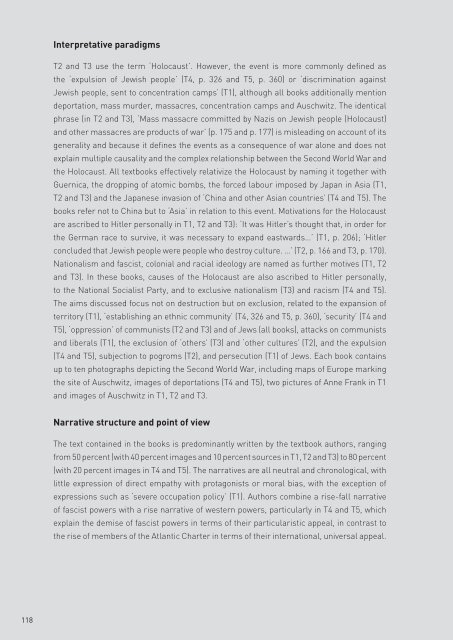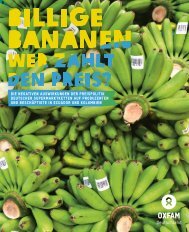228776e
228776e
228776e
Create successful ePaper yourself
Turn your PDF publications into a flip-book with our unique Google optimized e-Paper software.
Interpretative paradigms<br />
T2 and T3 use the term ‘Holocaust’. However, the event is more commonly defined as<br />
the ‘expulsion of Jewish people’ (T4, p. 326 and T5, p. 360) or ‘discrimination against<br />
Jewish people, sent to concentration camps’ (T1), although all books additionally mention<br />
deportation, mass murder, massacres, concentration camps and Auschwitz. The identical<br />
phrase (in T2 and T3), ‘Mass massacre committed by Nazis on Jewish people (Holocaust)<br />
and other massacres are products of war’ (p. 175 and p. 177) is misleading on account of its<br />
generality and because it defines the events as a consequence of war alone and does not<br />
explain multiple causality and the complex relationship between the Second World War and<br />
the Holocaust. All textbooks effectively relativize the Holocaust by naming it together with<br />
Guernica, the dropping of atomic bombs, the forced labour imposed by Japan in Asia (T1,<br />
T2 and T3) and the Japanese invasion of ‘China and other Asian countries’ (T4 and T5). The<br />
books refer not to China but to ‘Asia’ in relation to this event. Motivations for the Holocaust<br />
are ascribed to Hitler personally in T1, T2 and T3): ‘It was Hitler’s thought that, in order for<br />
the German race to survive, it was necessary to expand eastwards…’ (T1, p. 206); ‘Hitler<br />
concluded that Jewish people were people who destroy culture. …’ (T2, p. 166 and T3, p. 170).<br />
Nationalism and fascist, colonial and racial ideology are named as further motives (T1, T2<br />
and T3). In these books, causes of the Holocaust are also ascribed to Hitler personally,<br />
to the National Socialist Party, and to exclusive nationalism (T3) and racism (T4 and T5).<br />
The aims discussed focus not on destruction but on exclusion, related to the expansion of<br />
territory (T1), ‘establishing an ethnic community’ (T4, 326 and T5, p. 360), ‘security’ (T4 and<br />
T5), ‘oppression’ of communists (T2 and T3) and of Jews (all books), attacks on communists<br />
and liberals (T1), the exclusion of ‘others’ (T3) and ‘other cultures’ (T2), and the expulsion<br />
(T4 and T5), subjection to pogroms (T2), and persecution (T1) of Jews. Each book contains<br />
up to ten photographs depicting the Second World War, including maps of Europe marking<br />
the site of Auschwitz, images of deportations (T4 and T5), two pictures of Anne Frank in T1<br />
and images of Auschwitz in T1, T2 and T3.<br />
Narrative structure and point of view<br />
The text contained in the books is predominantly written by the textbook authors, ranging<br />
from 50 percent (with 40 percent images and 10 percent sources in T1, T2 and T3) to 80 percent<br />
(with 20 percent images in T4 and T5). The narratives are all neutral and chronological, with<br />
little expression of direct empathy with protagonists or moral bias, with the exception of<br />
expressions such as ‘severe occupation policy’ (T1). Authors combine a rise-fall narrative<br />
of fascist powers with a rise narrative of western powers, particularly in T4 and T5, which<br />
explain the demise of fascist powers in terms of their particularistic appeal, in contrast to<br />
the rise of members of the Atlantic Charter in terms of their international, universal appeal.<br />
118




